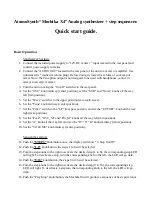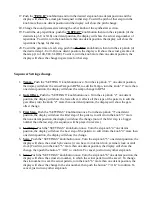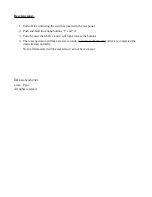
7.
Pattern
. Push the “SETTINGS” knob/button once. Turn the step knob “7” one detent position,
the display will show the number of the actual active pattern. To change the active pattern, turn
the knob “7” more than one detent position, the display will show the change in the pattern
number, then push the button “7 / OK” to confirm. To cancel, just turn any other step knob.
8.
Mode
. Push the “SETTINGS” knob/button once. Turn the step knob “8” one detent position,
the display will show the actual playing mode. To change the mode, turn the knob “8” more
than one detent position, the display will show the change in the mode, then push the button “7 /
OK” to confirm. To cancel, just turn any other step knob.
The MochikaX4 features 8 different playing modes:
•
Sequence.
Normal sequence (if the first step is set to a bigger number than the last step, the
sequence will play backwards).
•
Alternate
. Ping pong style (the first and last step are not played twice).
•
Random
. Plays in random order between first and last step. (in this mode, step repetitions
are ignored)
•
Drunk
. 50% probability of playing the next step, 25% of playing the same step and 25% of
playing the previous step. (in this mode, step repetitions are ignored)
•
Drone
. Plays the first step repeatedly, to get a continuous note, set a large gate time.
•
StpTrigger
. Gate and Pitch become separated, it plays the pitch of the next step, when there
is an active step only. (in this mode, step repetitions are ignored)
•
One Shot
. Play the sequence once.
•
MidiCtrl1...16
. In this mode the sinthesizer is controlled by an external midi device
connected to the midi input, the internal sequencer is disabled.
Midi operation.
1. Push the “SETTINGS” knob/button once, the display will show “7. Settings”.
2. Turn the step knob “8” until the display shows “Mode: MidiCtrl 1 … 16” (the number indicates
the midi channel), select the desired midi channel, to confirm push the button “7 / OK”
3. Connect a midi controller to the “MIDI In” connector located in the rear panel and set your
controller to the same midi channel.
4. Note: when in MidiCtrl mode, the sequencer is disabled, to enable the sequencer select a
different playing mode than MidiCtrl.
Summary of Contents for Mochika X4
Page 1: ......





